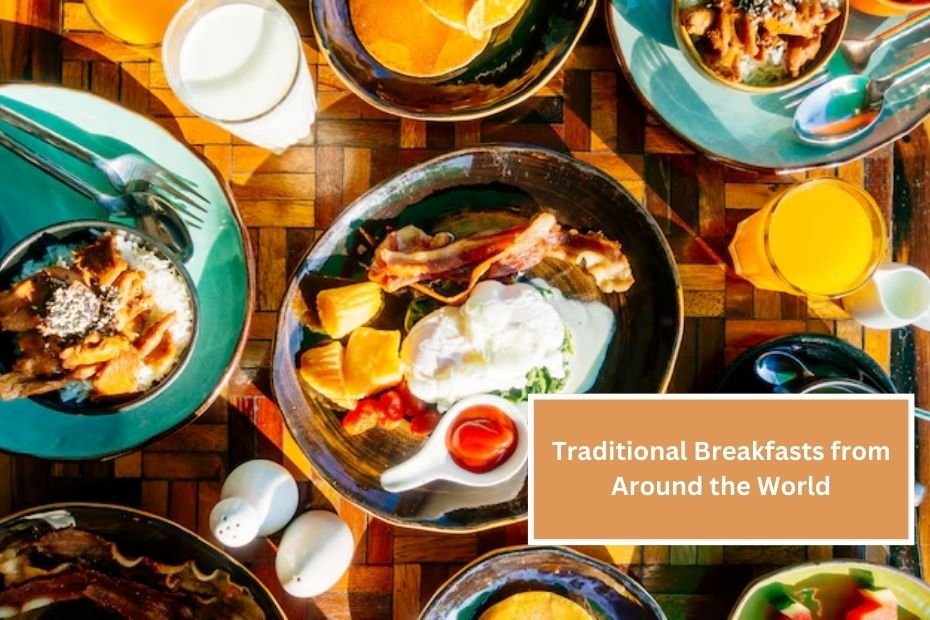Breakfast is often called the most important meal of the day, and for good reason! It gives you the energy you need to start your day and helps to kickstart your metabolism. Around the world, breakfast traditions vary widely, reflecting local ingredients, culture, and customs. This article will explore some delicious traditional breakfasts from different countries, highlighting their unique flavors and significance.
1. American Breakfast
In the United States, breakfast can vary from light to hearty. A typical American breakfast often includes eggs (fried, scrambled, or poached), bacon or sausage, pancakes or waffles served with maple syrup, and a side of fresh fruit. Many Americans enjoy a cup of coffee or orange juice to wash it down.
Cultural Significance: The American breakfast is hearty and filling, often reflecting the “go big or go home” mentality of American culture. Breakfast diners and brunch spots are popular, serving everything from omelets to elaborate pancake stacks.
2. English Breakfast
The traditional English breakfast, often referred to as a “full English,” consists of eggs, bacon, sausages, baked beans, grilled tomatoes, and toast. Some variations might include mushrooms and black pudding (a type of blood sausage).
Cultural Significance: This breakfast is a hearty meal that reflects the British tradition of starting the day with a substantial meal, often enjoyed on weekends or special occasions. It’s seen as a social event, with families and friends gathering for a leisurely meal.
3. Japanese Breakfast
In Japan, breakfast is typically lighter and consists of rice, miso soup, grilled fish, and pickled vegetables. Sometimes, it may include a rolled omelet known as tamagoyaki. Green tea is often the beverage of choice.
Cultural Significance: Japanese breakfast emphasizes balance and nutrition, with a focus on fresh, seasonal ingredients. It reflects the Japanese philosophy of harmony and simplicity, starting the day with mindful eating.
4. Mexican Breakfast
A traditional Mexican breakfast can be vibrant and flavorful, featuring dishes like chilaquiles (tortilla chips topped with salsa, cheese, and sometimes eggs), huevos rancheros (fried eggs served on tortillas with salsa), and refried beans. Fresh fruit and coffee are common accompaniments.
Cultural Significance: Breakfast in Mexico is often a communal event, bringing families together. The use of bold flavors and spices reflects Mexico’s rich culinary history and diverse regional ingredients.
5. French Breakfast
In France, breakfast is usually light and simple, often consisting of a croissant or baguette with butter and jam, accompanied by coffee or hot chocolate. Some may opt for a tartine (open-faced sandwich) topped with cheese or ham.
Cultural Significance: French breakfasts are about savoring each bite. They reflect the French appreciation for quality ingredients and leisurely dining, setting the tone for a relaxed day ahead.
6. Indian Breakfast
Indian breakfasts vary greatly by region but commonly include dishes like dosa (fermented rice and lentil crepes), idli (steamed rice cakes), or parathas (stuffed flatbreads). These are often served with chutneys and sambar (a lentil-based vegetable stew).
Cultural Significance: Indian breakfasts are often rich in spices and flavors, reflecting the country’s diverse culinary traditions. It’s a meal that brings families together, often prepared and enjoyed with love.
7. Chinese Breakfast
In China, breakfast can range from savory to sweet. Common dishes include congee (rice porridge), jianbing (savory crepes filled with vegetables and egg), and baozi (steamed buns filled with meat or vegetables). Tea is a popular beverage choice.
Cultural Significance: Chinese breakfast varies by region, showcasing local ingredients and flavors. It emphasizes the importance of balance in nutrition and is often enjoyed quickly before starting the day.
8. Italian Breakfast
An Italian breakfast is typically simple, featuring a cappuccino or espresso paired with a pastry like a cornetto (similar to a croissant). Biscotti or bread with jam may also be served.
Cultural Significance: Italian breakfasts are quick and sweet, emphasizing the importance of quality coffee and pastries. It reflects the Italian love for culinary tradition, even in simple meals.
9. Turkish Breakfast
A traditional Turkish breakfast is a feast of various dishes, including olives, cheeses, tomatoes, cucumbers, honey, and eggs. It is often served with fresh bread and tea.
Cultural Significance: Turkish breakfasts are known for their communal nature, where friends and family gather to share a variety of dishes. It reflects the rich agricultural heritage of Turkey and the importance of sharing food.
10. Lebanese Breakfast
Lebanese breakfasts are often delicious and healthy, featuring labneh (strained yogurt), hummus, tabbouleh (parsley salad), olives, and pita bread. Fresh vegetables and a cup of mint tea may accompany the meal.
Cultural Significance: This breakfast reflects the Lebanese love for fresh, healthy ingredients and the importance of communal dining. Meals are often shared among family and friends, emphasizing togetherness.
11. Brazilian Breakfast
In Brazil, breakfast can be a mix of sweet and savory, often including pão de queijo (cheese bread), fruits, and coffee. In some regions, açaí bowls are popular, made from the açaí berry topped with granola and bananas.
Cultural Significance: Brazilian breakfasts are often light but refreshing, reflecting the country’s tropical climate and love for fresh produce. They’re a great way to start the day with energy.
12. Russian Breakfast
In Russia, a traditional breakfast might include kasha (gruel made from grains), blini (thin pancakes), or eggs. Often, sour cream and jam are served on the side, along with tea.
Cultural Significance: Russian breakfasts are hearty and often practical, reflecting the need for sustenance in a cold climate. The use of grains shows the importance of agriculture in Russian culture.
13. Egyptian Breakfast
An Egyptian breakfast typically features ful medames (stewed fava beans), ta’ameya (Egyptian falafel), and flatbread. It may be accompanied by fresh vegetables and a hot drink.
Cultural Significance: Egyptian breakfasts are rich in flavors and nutrition, often enjoyed in a social setting. They reflect the country’s agricultural heritage and love for shared meals.
14. South African Breakfast
In South Africa, breakfast can include boerewors (sausage), eggs, and baked beans, often served with toast. Some may enjoy traditional dishes like pap (cornmeal porridge) with milk and sugar.
Cultural Significance: South African breakfasts showcase the country’s diverse culinary traditions, blending influences from various cultures. It reflects the importance of family and community in sharing meals.
15. Australian Breakfast
A traditional Australian breakfast often includes Vegemite (a spread made from yeast extract) on toast, avocado on toast, and a variety of fresh fruits. A flat white coffee is a popular beverage choice.
Cultural Significance: Australian breakfasts are known for their simplicity and fresh ingredients. They reflect the country’s laid-back lifestyle and love for the outdoors.
16. Indonesian Breakfast
In Indonesia, breakfast often includes nasi goreng (fried rice) topped with a fried egg, alongside sambal (spicy chili paste) and fried chicken or tofu. Fresh fruit is a common side.
Cultural Significance: Indonesian breakfasts are bold and flavorful, showcasing the country’s rich culinary heritage. They emphasize the use of spices and fresh ingredients, reflecting local agricultural practices.
17. Finnish Breakfast
A typical Finnish breakfast features rye bread, cheese, and cold cuts, often served with yogurt and berries. Coffee or tea is a common beverage choice.
Cultural Significance: Finnish breakfasts highlight the importance of simplicity and health, with a focus on whole grains and fresh produce. They reflect the country’s agricultural practices and seasonal ingredients.
18. Greek Breakfast
Greek breakfasts often include yogurt with honey and nuts, olives, and bread. Some may enjoy a slice of spanakopita (spinach pie) or tiropita (cheese pie).
Cultural Significance: Greek breakfasts are a blend of sweet and savory, reflecting the country’s rich culinary traditions. They emphasize the use of fresh, local ingredients and the importance of family meals.
19. Malaysian Breakfast
In Malaysia, breakfast can be a mix of flavors, featuring nasi lemak (coconut rice served with sambal, fried egg, peanuts, and cucumber) and roti canai (flaky flatbread served with curry).
Cultural Significance: Malaysian breakfasts are diverse, showcasing the country’s multicultural influences. They reflect the blend of flavors and ingredients from various ethnic groups within the country.
20. Vietnamese Breakfast
Vietnamese breakfasts often include pho (noodle soup) or banh mi (a Vietnamese sandwich). A bowl of pho consists of broth, rice noodles, herbs, and meat, while banh mi is a delicious blend of flavors in a crispy baguette.
Cultural Significance: Vietnamese breakfasts highlight the importance of fresh ingredients and balanced flavors. They reflect the country’s culinary heritage and the social aspect of sharing meals.
Conclusion
Breakfast traditions around the world are as diverse as the cultures they come from. From hearty American breakfasts to light Japanese meals, each tradition reflects local ingredients, customs, and the importance of gathering around the table. As you explore these breakfast dishes, consider trying to make some at home. Not only will you enjoy new flavors, but you’ll also experience a taste of different cultures, making breakfast a truly global affair.

